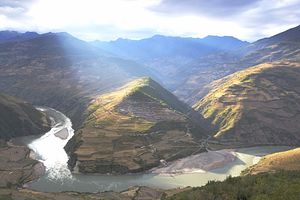China has promised to discharge water from a dam along the Lancang River (better known as the Mekong) to help alleviate drought conditions in Southeast Asia. Foreign Ministry spokesperson Lu Kang announced Tuesday in a regular press conference that China will release water from the Jinghong hydropower station in Yunnan province from March 15 to April 10, to provide water “for emergency use” by countries downstream.
“People living along the Lancang-Mekong River are nourished by the same river,” Lu noted. “It goes without saying that friends should help each other when help is needed.”
Yet the question of dams on the Mekong has not been as friendly as Lu makes it seem. As The Diplomat’s Luke Hunt noted last week, Thailand, Vietnam, Laos, and Cambodia have been squabbling over dam construction and water usage, particularly as a severe drought threatens rice crop yields across the Indochina Peninsula.
China is also a part of that conversation – a major part, as the Mekong (called the Lancang in China) originates on the Tibetan plateau and flows through the provinces of Qinghai, Tibet, and Yunnan before ever reaching Southeast Asia. China opened its first large dam on the Lancang, the Manwan in Yunnan, in 1994, and added the Dachaoshan dam in 2003. In recent years, hydropower construction has revved into high gear, with China completing four additional dams since 2009 — and plans for another seven in the works.
With the Mekong’s health an increasing sources of worry, the countries downstream – Cambodia, Laos, Myanmar, Thailand, and Vietnam – have reason to be concerned about China’s hydropower plans. This is not specific to China, per se; Laos’ plan to build two new dams on the Mekong has similarly sparked criticisms from its downstream neighbors. But China has the longest history of dam-building, and has already faced specific criticisms for causing both droughts and floods as its new projects came online. China also has a history, however, of releasing extra water from its dams when water shortages downstream become dire.
Thus Vietnam reportedly requested that China discharge water from the Jinghong dam to help alleviate the current drought. Lu, in his announcement, was careful to blame the current situation on natural causes – “the El Nino phenomenon” – rather than man-made alterations to the river. The release of additional water from China to the Lower Mekong, Lu suggested, is a sign of goodwill from Beijing: “In order to help those countries cope with the drought, the Chinese government decided to surmount the difficulties it faces and do its utmost to help.”
The current drought – and China’s offer to discharge water – comes only a few months after the launch of the new Lancang-Mekong Cooperation Mechanism (LMCM), which is intended (among other things) to help coordinate the use of water resources along the river. The LMCM includes China, Cambodia, Laos, Myanmar, Thailand, and Vietnam. Notably, China is not a full member of the existing framework for handling water resources issues, the Mekong River Commission (which now faces major difficulties due to a budget shortfall and perceived “political bullying” from Laos, which houses the organization).
Under the LMCM, which was founded with strong Chinese backing, Lu promised that “the Chinese side will enhance communication and coordination with relevant countries on water resources management and disaster response to carry out practical cooperation, which we hope will better benefit people living along the Lancang-Mekong River.”

































